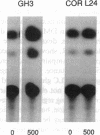Abstract
Some human small cell lung carcinomas (SCLC) secrete proopiomelanocortin (POMC) derived peptides, but in contrast to the pituitary, glucocorticoids fail to inhibit this hormone production. We have previously described an in vitro model using human SCLC cell lines that express POMC and are resistant to glucocorticoids. We have now identified the glucocorticoid receptor (GR) in the SCLC cell line COR L24 using a whole cell ligand binding assay (Kd = 5.7 nM; Bmax = 11 fmol/million cells), while another cell line, DMS 79, lacked significant glucocorticoid binding. To analyze GR function both positive (GMCO) and negative (TRE)3-tkCAT), glucocorticoid-regulated reporter gene constructs were transfected into COR L24 cells. In the SCLC cell line, neither hydrocortisone nor dexamethasone (500-2,000 nM) significantly induced chloramphenicol acetyltransferase expression from GMCO; in addition, they did not suppress chloramphenicol acetyltransferase expression from (TRE)3-tkCAT. Similar results were obtained with two other POMC-expressing SCLC cell lines. Expression of wild type GR in COR L24 cells restored glucocorticoid signaling, with marked induction of GMCO reporter gene expression by dexamethasone (9,100 +/- 910%; n = 3), and an estimated EC50 of 10 nM. This failure of the GR explains the resistance of the POMC gene to glucocorticoid inhibition and may have implications for cell growth in SCLC.
Full text
PDF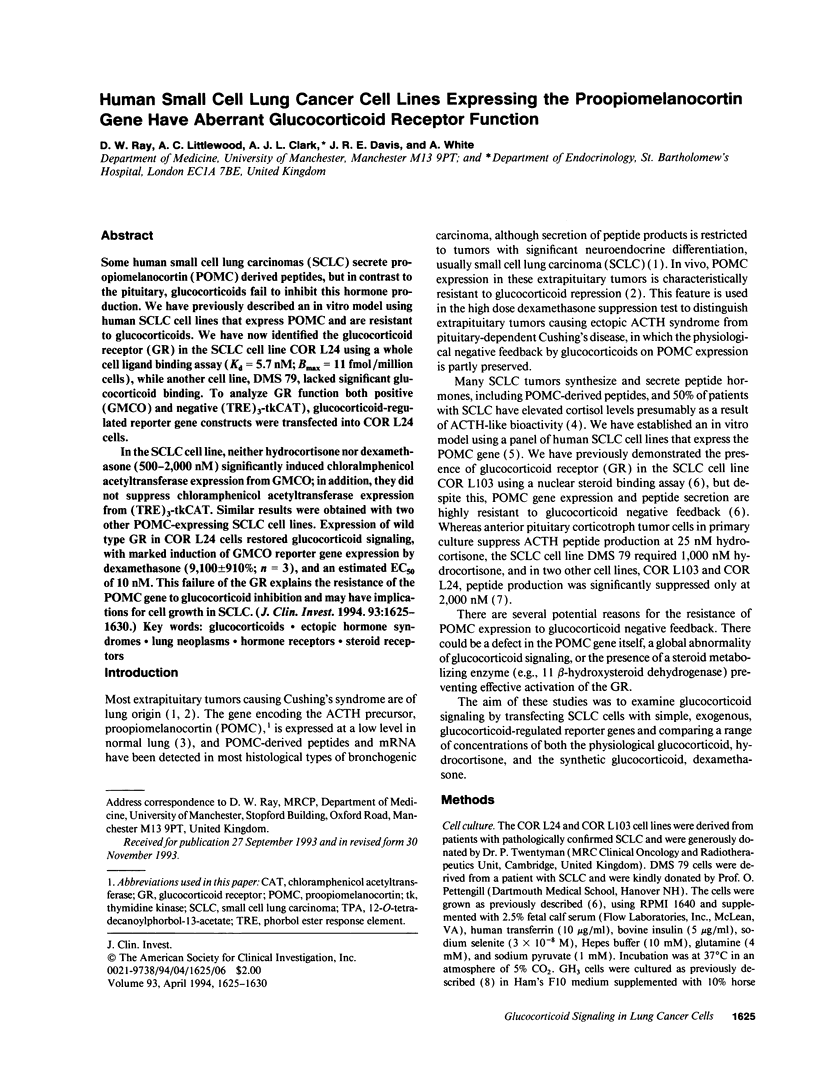
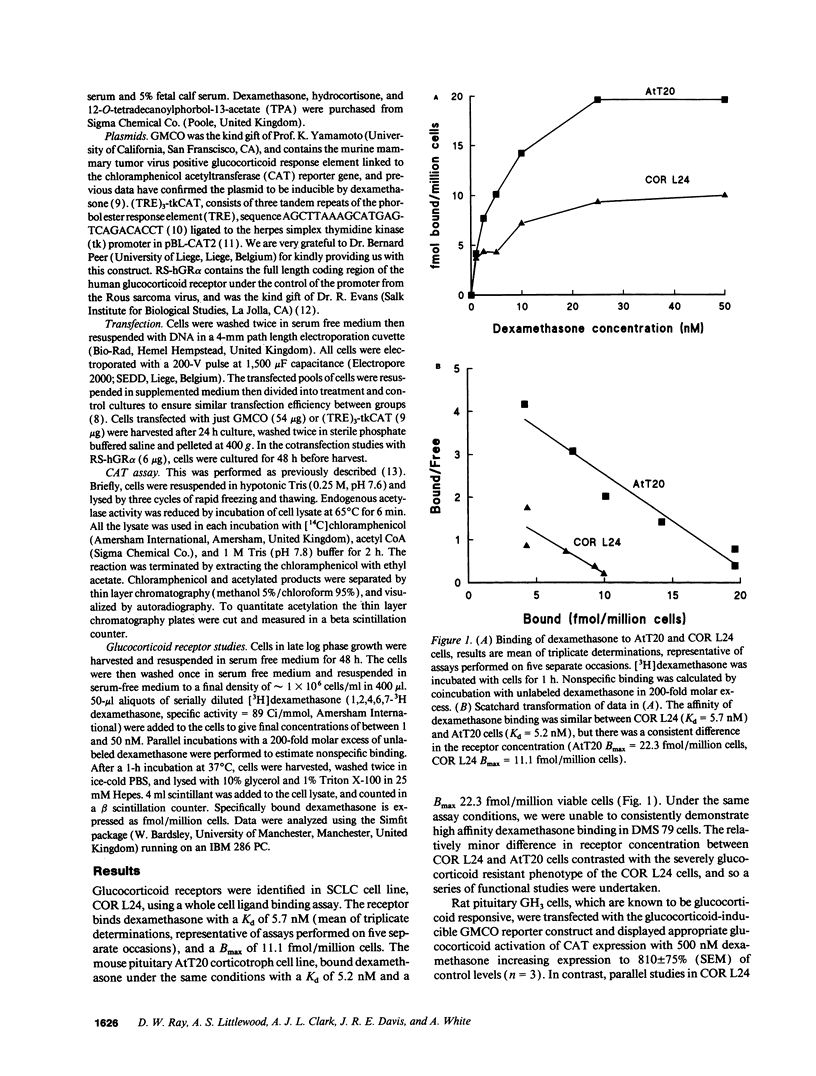
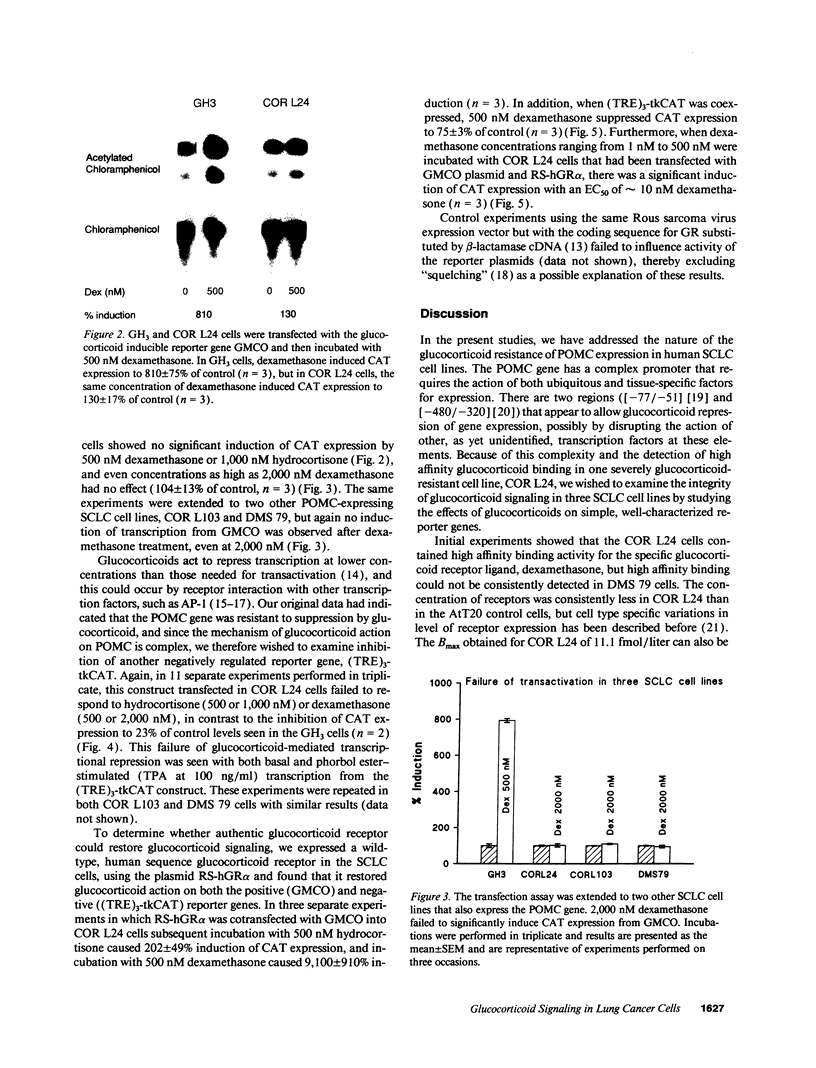
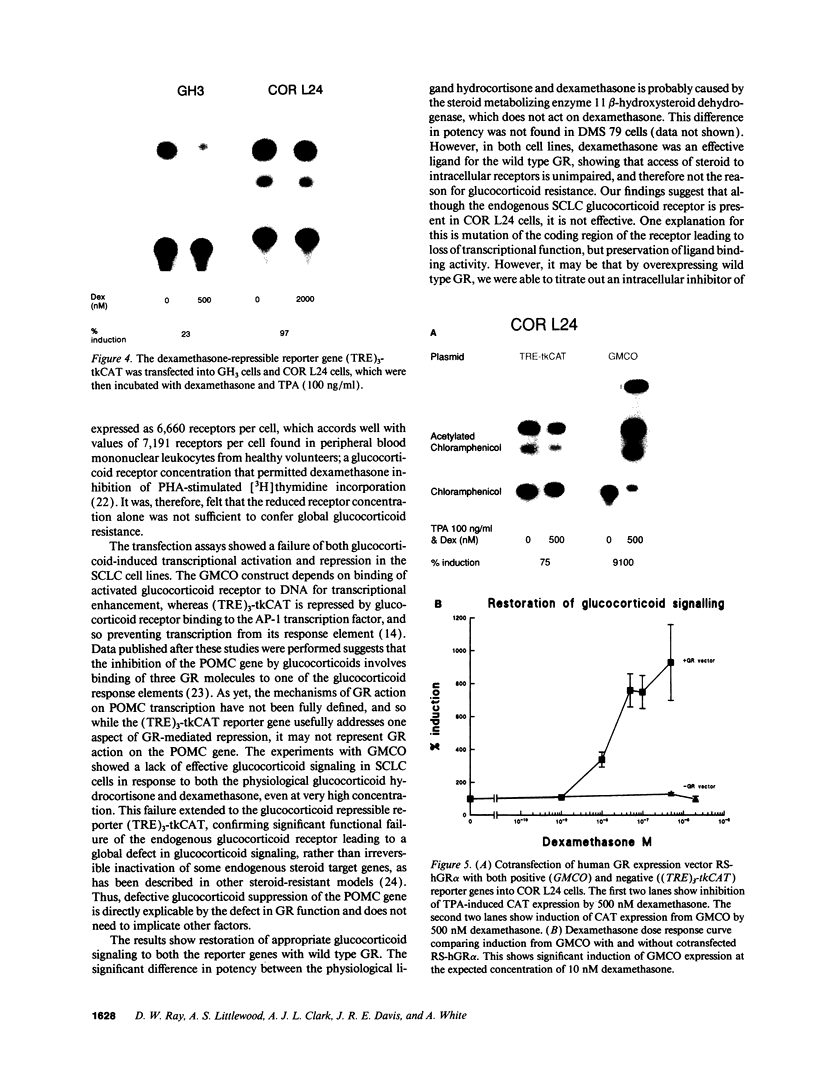

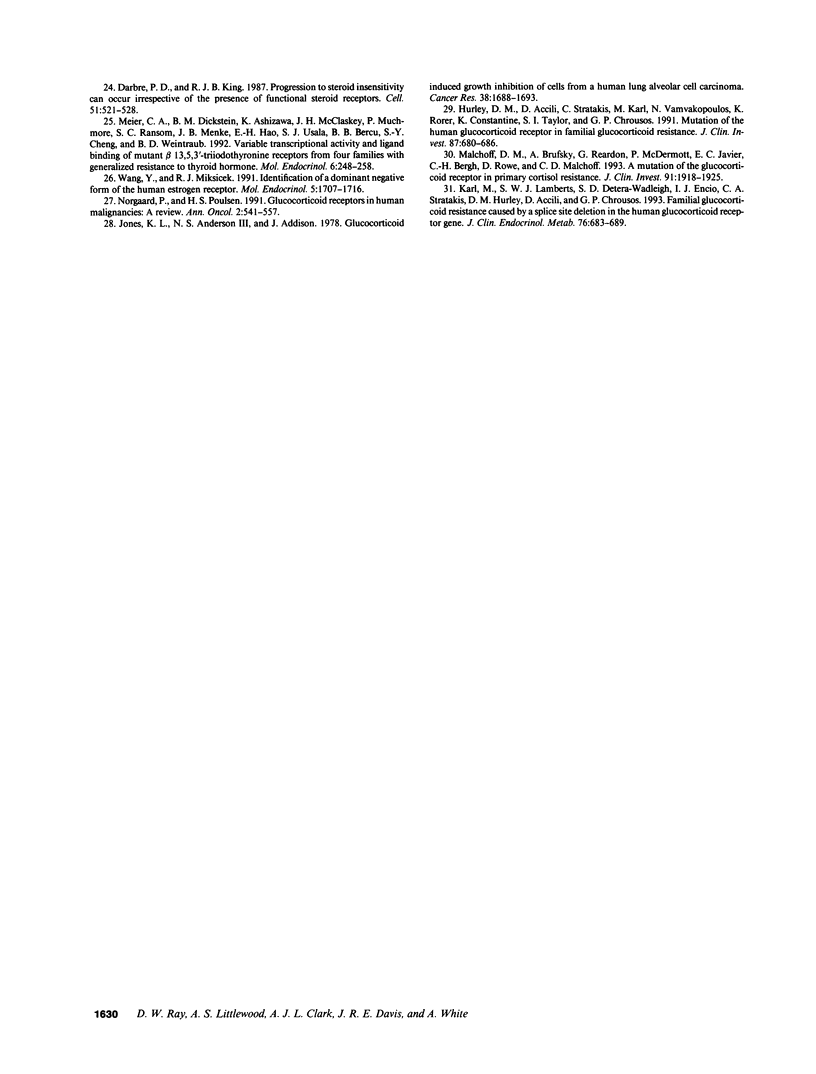
Images in this article
Selected References
These references are in PubMed. This may not be the complete list of references from this article.
- Angel P., Imagawa M., Chiu R., Stein B., Imbra R. J., Rahmsdorf H. J., Jonat C., Herrlich P., Karin M. Phorbol ester-inducible genes contain a common cis element recognized by a TPA-modulated trans-acting factor. Cell. 1987 Jun 19;49(6):729–739. doi: 10.1016/0092-8674(87)90611-8. [DOI] [PubMed] [Google Scholar]
- Chatterjee V. K., Madison L. D., Mayo S., Jameson J. L. Repression of the human glycoprotein hormone alpha-subunit gene by glucocorticoids: evidence for receptor interactions with limiting transcriptional activators. Mol Endocrinol. 1991 Jan;5(1):100–110. doi: 10.1210/mend-5-1-100. [DOI] [PubMed] [Google Scholar]
- Clark A. J., Stewart M. F., Lavender P. M., Farrell W., Crosby S. R., Rees L. H., White A. Defective glucocorticoid regulation of proopiomelanocortin gene expression and peptide secretion in a small cell lung cancer cell line. J Clin Endocrinol Metab. 1990 Feb;70(2):485–490. doi: 10.1210/jcem-70-2-485. [DOI] [PubMed] [Google Scholar]
- Darbre P. D., King R. J. Progression to steroid insensitivity can occur irrespective of the presence of functional steroid receptors. Cell. 1987 Nov 20;51(4):521–528. doi: 10.1016/0092-8674(87)90121-8. [DOI] [PubMed] [Google Scholar]
- Diamond M. I., Miner J. N., Yoshinaga S. K., Yamamoto K. R. Transcription factor interactions: selectors of positive or negative regulation from a single DNA element. Science. 1990 Sep 14;249(4974):1266–1272. doi: 10.1126/science.2119054. [DOI] [PubMed] [Google Scholar]
- Drouin J., Sun Y. L., Chamberland M., Gauthier Y., De Léan A., Nemer M., Schmidt T. J. Novel glucocorticoid receptor complex with DNA element of the hormone-repressed POMC gene. EMBO J. 1993 Jan;12(1):145–156. doi: 10.1002/j.1460-2075.1993.tb05640.x. [DOI] [PMC free article] [PubMed] [Google Scholar]
- Drouin J., Trifiro M. A., Plante R. K., Nemer M., Eriksson P., Wrange O. Glucocorticoid receptor binding to a specific DNA sequence is required for hormone-dependent repression of pro-opiomelanocortin gene transcription. Mol Cell Biol. 1989 Dec;9(12):5305–5314. doi: 10.1128/mcb.9.12.5305. [DOI] [PMC free article] [PubMed] [Google Scholar]
- Farrell W. E., Stewart M. F., Clark A. J., Crosby S. R., Davis J. R., White A. Glucocorticoid inhibition of ACTH peptides: small cell lung cancer cell lines are more resistant than pituitary corticotroph adenoma cells. J Mol Endocrinol. 1993 Feb;10(1):25–32. doi: 10.1677/jme.0.0100025. [DOI] [PubMed] [Google Scholar]
- Giguère V., Hollenberg S. M., Rosenfeld M. G., Evans R. M. Functional domains of the human glucocorticoid receptor. Cell. 1986 Aug 29;46(5):645–652. doi: 10.1016/0092-8674(86)90339-9. [DOI] [PubMed] [Google Scholar]
- Godowski P. J., Picard D., Yamamoto K. R. Signal transduction and transcriptional regulation by glucocorticoid receptor-LexA fusion proteins. Science. 1988 Aug 12;241(4867):812–816. doi: 10.1126/science.3043662. [DOI] [PubMed] [Google Scholar]
- Gorman C. M., Moffat L. F., Howard B. H. Recombinant genomes which express chloramphenicol acetyltransferase in mammalian cells. Mol Cell Biol. 1982 Sep;2(9):1044–1051. doi: 10.1128/mcb.2.9.1044. [DOI] [PMC free article] [PubMed] [Google Scholar]
- Hoggard N., Davis J. R., Berwaer M., Monget P., Peers B., Belayew A., Martial J. A. Pit-1 binding sequences permit calcium regulation of human prolactin gene expression. Mol Endocrinol. 1991 Nov;5(11):1748–1754. doi: 10.1210/mend-5-11-1748. [DOI] [PubMed] [Google Scholar]
- Hurley D. M., Accili D., Stratakis C. A., Karl M., Vamvakopoulos N., Rorer E., Constantine K., Taylor S. I., Chrousos G. P. Point mutation causing a single amino acid substitution in the hormone binding domain of the glucocorticoid receptor in familial glucocorticoid resistance. J Clin Invest. 1991 Feb;87(2):680–686. doi: 10.1172/JCI115046. [DOI] [PMC free article] [PubMed] [Google Scholar]
- Imura H., Matsukura S., Yamamoto H., Hirata Y., Nakai Y. Studies on ectopic ACTH-producing tumors. II. Clinical and biochemical features of 30 cases. Cancer. 1975 May;35(5):1430–1437. doi: 10.1002/1097-0142(197505)35:5<1430::aid-cncr2820350529>3.0.co;2-o. [DOI] [PubMed] [Google Scholar]
- Jonat C., Rahmsdorf H. J., Park K. K., Cato A. C., Gebel S., Ponta H., Herrlich P. Antitumor promotion and antiinflammation: down-modulation of AP-1 (Fos/Jun) activity by glucocorticoid hormone. Cell. 1990 Sep 21;62(6):1189–1204. doi: 10.1016/0092-8674(90)90395-u. [DOI] [PubMed] [Google Scholar]
- Jones K. L., Anderson N. S., 3rd, Addison J. Glucocorticoid-induced growth inhibition of cells from a human lung alveolar cell carcinoma. Cancer Res. 1978 Jun;38(6):1688–1693. [PubMed] [Google Scholar]
- Kalinyak J. E., Griffin C. A., Hamilton R. W., Bradshaw J. G., Perlman A. J., Hoffman A. R. Developmental and hormonal regulation of glucocorticoid receptor messenger RNA in the rat. J Clin Invest. 1989 Dec;84(6):1843–1848. doi: 10.1172/JCI114370. [DOI] [PMC free article] [PubMed] [Google Scholar]
- Karl M., Lamberts S. W., Detera-Wadleigh S. D., Encio I. J., Stratakis C. A., Hurley D. M., Accili D., Chrousos G. P. Familial glucocorticoid resistance caused by a splice site deletion in the human glucocorticoid receptor gene. J Clin Endocrinol Metab. 1993 Mar;76(3):683–689. doi: 10.1210/jcem.76.3.8445027. [DOI] [PubMed] [Google Scholar]
- Lamberts S. W., Koper J. W., Biemond P., den Holder F. H., de Jong F. H. Cortisol receptor resistance: the variability of its clinical presentation and response to treatment. J Clin Endocrinol Metab. 1992 Feb;74(2):313–321. doi: 10.1210/jcem.74.2.1309833. [DOI] [PubMed] [Google Scholar]
- Liddle G. W., Nicholson W. E., Island D. P., Orth D. N., Abe K., Lowder S. C. Clinical and laboratory studies of ectopic humoral syndromes. Recent Prog Horm Res. 1969;25:283–314. doi: 10.1016/b978-0-12-571125-8.50009-0. [DOI] [PubMed] [Google Scholar]
- Luckow B., Schütz G. CAT constructions with multiple unique restriction sites for the functional analysis of eukaryotic promoters and regulatory elements. Nucleic Acids Res. 1987 Jul 10;15(13):5490–5490. doi: 10.1093/nar/15.13.5490. [DOI] [PMC free article] [PubMed] [Google Scholar]
- Malchoff D. M., Brufsky A., Reardon G., McDermott P., Javier E. C., Bergh C. H., Rowe D., Malchoff C. D. A mutation of the glucocorticoid receptor in primary cortisol resistance. J Clin Invest. 1993 May;91(5):1918–1925. doi: 10.1172/JCI116410. [DOI] [PMC free article] [PubMed] [Google Scholar]
- Meier C. A., Dickstein B. M., Ashizawa K., McClaskey J. H., Muchmore P., Ransom S. C., Menke J. B., Hao E. H., Usala S. J., Bercu B. B. Variable transcriptional activity and ligand binding of mutant beta 1 3,5,3'-triiodothyronine receptors from four families with generalized resistance to thyroid hormone. Mol Endocrinol. 1992 Feb;6(2):248–258. doi: 10.1210/mend.6.2.1569968. [DOI] [PubMed] [Google Scholar]
- Nørgaard P., Poulsen H. S. Glucocorticoid receptors in human malignancies: a review. Ann Oncol. 1991 Sep;2(8):541–557. doi: 10.1093/oxfordjournals.annonc.a058018. [DOI] [PubMed] [Google Scholar]
- Ptashne M. How eukaryotic transcriptional activators work. Nature. 1988 Oct 20;335(6192):683–689. doi: 10.1038/335683a0. [DOI] [PubMed] [Google Scholar]
- Riegel A. T., Lu Y., Remenick J., Wolford R. G., Berard D. S., Hager G. L. Proopiomelanocortin gene promoter elements required for constitutive and glucocorticoid-repressed transcription. Mol Endocrinol. 1991 Dec;5(12):1973–1982. doi: 10.1210/mend-5-12-1973. [DOI] [PubMed] [Google Scholar]
- Texier P. L., de Keyzer Y., Lacave R., Vieau D., Lenne F., Rojas-Miranda A., Verley J. M., Luton J. P., Kahn A., Bertagna X. Proopiomelanocortin gene expression in normal and tumoral human lung. J Clin Endocrinol Metab. 1991 Aug;73(2):414–420. doi: 10.1210/jcem-73-2-414. [DOI] [PubMed] [Google Scholar]
- Wang Y., Miksicek R. J. Identification of a dominant negative form of the human estrogen receptor. Mol Endocrinol. 1991 Nov;5(11):1707–1715. doi: 10.1210/mend-5-11-1707. [DOI] [PubMed] [Google Scholar]
- White A., Stewart M. F., Farrell W. E., Crosby S. R., Lavender P. M., Twentyman P. R., Rees L. H., Clark A. J. Pro-opiomelanocortin gene expression and peptide secretion in human small-cell lung cancer cell lines. J Mol Endocrinol. 1989 Jul;3(1):65–70. doi: 10.1677/jme.0.0030065. [DOI] [PubMed] [Google Scholar]
- Yang-Yen H. F., Chambard J. C., Sun Y. L., Smeal T., Schmidt T. J., Drouin J., Karin M. Transcriptional interference between c-Jun and the glucocorticoid receptor: mutual inhibition of DNA binding due to direct protein-protein interaction. Cell. 1990 Sep 21;62(6):1205–1215. doi: 10.1016/0092-8674(90)90396-v. [DOI] [PubMed] [Google Scholar]



